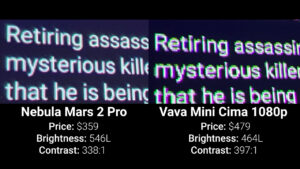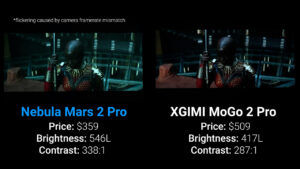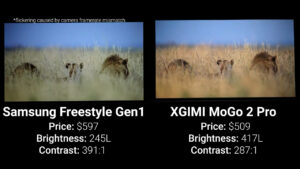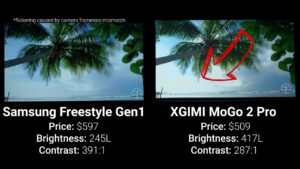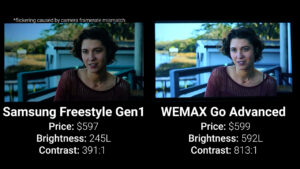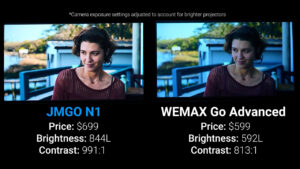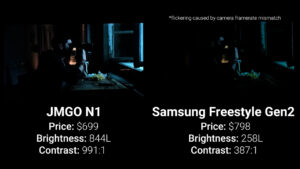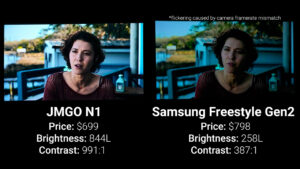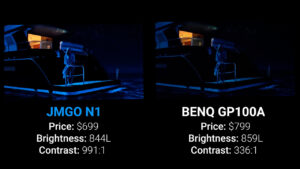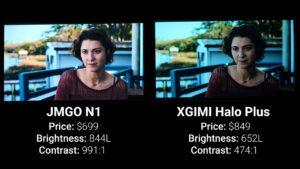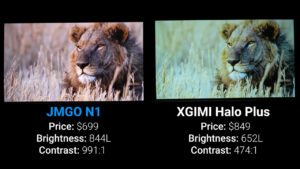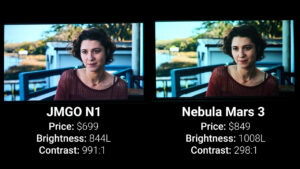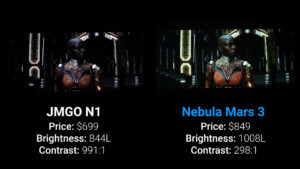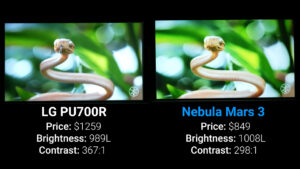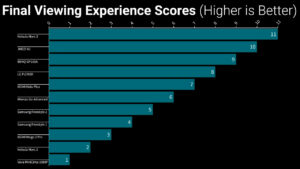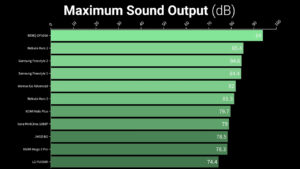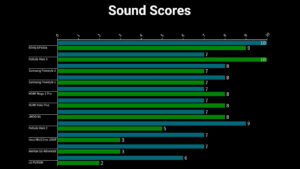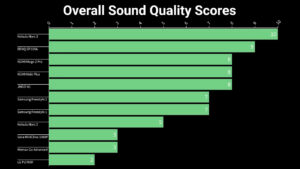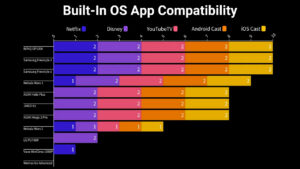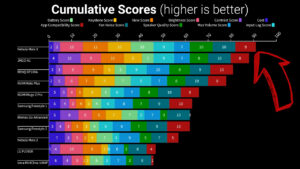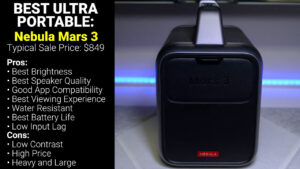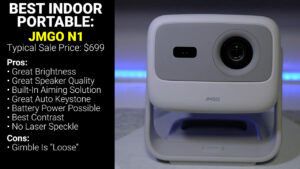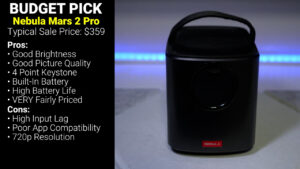2023 Ultimate Portable Projector Comparison
December 7, 2023The definition of a portable projector has changed a lot in last 2 years, but whether you prioritize overall size, brightness, picture quality, battery life, ease of setup, sound quality, or app compatibility at least one of these 11 projectors should work for you. As always there are no sponsored reviews on this channel, so let’s get testing.
BRIGHTNESS, CONTRAST, KEYSTONE, FAN NOISE
With a street price of $369 the least expensive projector in this video is the Nebula Mars 2 Pro, which has been my budget portable pick for the last two years. The Nebula Mars 2 Pro has 720p resolution and a 48 watt-hour battery. The Mars 2 Pro is the oldest projector we’ll be testing running Android 7.1, but despite being old the Mars 2 Pro has auto focus and recently received a firmware update replacing its vertical only keystone with a much more useful 4-point corner pinning setup.
The Mars 2 Pro has HDMI and USB connectivity with audio out and is equipped with a standard quarter twenty tripod mount but lacks any built-in kickstand or aiming solution. The Mars 2 Pro is mostly made of plastic and weighs in at 1560 grams.
The most important feature of any projector is brightness, so in the first test I used the ANSI lumen standard to measure each projector’s actual brightness by taking a reading at nine separate points on an all-white screen, averaging those measurements and multiplying by the screen size in square meters.
Using this method, the Nebula Mars 2 Pro measured 546 ANSI lumens on full brightness and 321 ANSI lumens on battery saving eco mode. Comparing the all-white screen to an all-black screen, the Mars 2 Pro had a less than impressive contrast ratio of 338:1, and the fan noise on the Mars 2 Pro was 44.4 decibels measured from 12 inches behind the projector.
After that for a price of $479 is the Vava Mini Cima 1080p, which as the name suggests is a 1080p portable mini projector with a 61 watt-hour built-in battery. Despite being a newer projector the Vava Cima runs Android 9.0, which is very outdated at this point, and while the Vava Cima has automatic focus and vertical keystone it lacks any form of horizontal keystone, which seems like a massive oversight for a new portable projector in 2023.
The Vava Cima uses USB-C for power and also has USB-C video in, HDMI video in, headphone out and a USB-A port for power and data. The Cima has a small built-in kickstand for aiming as well as a standard quarter twenty tripod mount. The Cima is mostly plastic and weighs in at 909 grams.
In my testing the Vava Cima significantly exceeded its 400 claimed lumens with my unit measuring 464 ANSI lumens on max brightness and 307 ANSI lumens on battery saving eco mode. The Vava Cima also exceeded its claimed 300:1 contrast ratio, measuring over 30% higher at 397:1. The Vava Cima’s fan was quiet but noticeable at around 39.9 decibels.
Next for a street price around $510 is the XGIMI Mogo 2 Pro, which is the most recent addition to XGIMI’s line of portable projectors. The Mogo 2 Pro is 1080p and is the first projector in this video that doesn’t have a built-in battery, but can be powered by an external battery bank via USB-C.
The Mogo 2 Pro runs Android 11 and has an upgraded auto keystone system allowing it to make corrections on the fly without interrupting your video. The Mogo 2 Pro has a standard quarter twenty tripod mount on the bottom and works best when paired with the XGIMI multi angle stand for easy aiming and setup on any surface. The Mogo 2 Pro looks and feels high quality with plastic and metal construction and weighs in at a hefty 1065 grams despite not having a battery.
In my testing the Mogo 2 Pro slightly exceeded its 400 lumen claim measuring 417 ANSI lumens on max brightness when powered with the XGIMI power brick, but only 361 ANSI lumens when powered via USB-C and a PD3.1 Battery Bank. The Mogo 2 Pro had the lowest measured contrast so far at 287:1 but its fan noise was mostly imperceptible and lower than the noise floor of my room, coming in at less than 36.4 decibels.
After that for a common street price around $597 is the Samsung Freestyle 1st Generation. The Freestyle has 1080p resolution and also lacks a built-in battery, but you can buy an official Samsung Freestyle battery base for $189 which like the Freestyle itself is alarmingly overpriced for its advertised 115 watt-hours of capacity.
The Freestyle runs on Samsung’s Tizen OS which has excellent app compatibility but is painfully slow on the Freestyle Gen 1, and one of many reasons that the original Freestyle launch was a failure. The Freestyle’s best feature is its built-in stand, which makes aiming and setup extremely simple, but the Freestyle Gen 1’s auto focus and auto keystone abilities are significantly buggier and worse than most of the other projectors in this video and it fails to make a rectangular screen more often than not.
Another drawback of the Samsung Freestyle is that its only connectivity is a HDMI mini port since the USB-C port is needed for power. Aside from the metal base, the rest of the Freestyle is made of plastic wrapped in a silicone sleeve and the Freestyle Gen 1 weighs in at 774 grams.
Samsung still lists 550 lumens on its website but using the ANSI standard the Freestyle measures much lower than that at just 245 ANSI lumens with a contrast ratio of 391:1. The Freestyle also has a very noticeable and recognizable fan noise that measures around 38.3 decibels.
Following that is one of my top picks from last year’s video, the Wemax Go Advanced, which costs around $600 for 1080p resolution, a laser light source, and a built-in 39 watt-hour battery. The Wemax runs FengOS built on top of Android TV9, which is an outdated OS but still has both vertical and horizontal keystone as well as auto focus. For connectivity, the Wemax has HDMI in, audio out, USB-A, and USB-C for power.
The construction of the Wemax Go Advanced feels extremely premium with all metal construction and a sleek sliding lens cover. Unfortunately, this means it lacks any on device controls, and also doesn’t have a tripod mounting location so you’ll need to rely on the small built-in kickstand for aiming. The Wemax weighs in at 789 grams.
When plugged in, the Wemax’s laser light source produces an impressive 592 ANSI lumens but is limited to approximately 275 ANSI lumens on battery power. In addition to the highest brightness, the Wemax Go Advanced also had the highest contrast ratio yet at 813:1. The Wemax’s fan was faintly noticeable, but still under the noise floor of the room at 36.4 decibels.
Following that up for a street price of around $700 is the JMGO N1. This is not the N1 Ultra or N1 Pro, but a smaller white version that includes 1080p resolution and JMGO’s MALC triple laser light source running at much lower power. The N1 doesn’t have a built-in battery, but as I’ll explain later can run extremely well from a USB battery bank using a $15 third party cable. Like its bigger brothers, the N1 includes an Android 11 operating system with auto focus and auto keystone to complement its built-in aiming mechanism, although if you’re used to the flawless aiming and auto keystone of the N1 Ultra the comparatively sloppy gimble and keystone of the N1 will be a bit of a letdown.
The N1 has HDMI and USB connectivity as well as audio out, and even with it’s all plastic construction and no battery it weighs in at a hefty 1929 grams.
JMGO advertises 800 CVIA lumens on the N1, and I measured 844 ANSI lumens on full brightness, and 350 ANSI lumens on laser level 4, which will be important later when talking about battery life. The JMGO’s contrast ratio was the best yet at an impressive 991:1 and if you’ve seen any of my reviews of the JMGO N1 Ultra you’ll be happy to know that I don’t notice any laser speckle on this smaller N1. Like the XGIMI Mogo 2 Pro, the N1’s fan noise was below the noise floor of my room, measuring somewhere less than 36.4 decibels.
After that for $798 is the Samsung Freestyle 2nd Generation, which is basically identical to the first generation Freestyle. It’s 1080p, lacks a battery, has minimal connectivity, and pairs a metal base and plastic body with a silicone outer sleeve, weighing in 23 grams heavier than the Gen 1 at 797 grams. The biggest difference I noticed in my testing was that the Gen 2 Freestyle has a much more powerful processor making Tizen OS more usable and significantly less laggy. The auto keystone seemed to be slightly better than the Gen 1 system, but I found the focusing mechanism to be worse than the Gen 1, and changing focus physically rotates the entire screen.
Samsung still advertises the same 550 lumens, and while the Gen 2 did squeeze out 13 more ANSI lumens than the gen 1, it’s still less than half of what Samsung advertises at just 258 ANSI lumens, and has basically the same contrast as the Gen 1 at 387:1. The fan is also unchanged and has the exact same tone and volume at 38.3 decibels.
Next for $799 is the BENQ GP100A, a 1080p 4LED projector. The BENQ doesn’t have a built-in battery, but it can be powered either by the BENQ power brick, or by USB-C where it will automatically adjust its brightness based on the power delivery capabilities of the battery bank.
The BENQ uses BENQ’s built-in streaming dongle that installs inside the case which runs Android 11 but allows BENQ to get around the annoying Netflix certification issues that prevent it from running properly on other projectors.
It also means that the BENQ has its own projector specific menus independent from the Android operating system which handles the auto focus and keystone. In addition to the streaming dongle the BENQ has HDMI, USB-A, and USB-C connectivity as well as audio out, but in my testing the USB port doesn’t provide enough current to power a Firestick, and HDMI CEC didn’t appear to be working properly on the exterior HDMI port.
The BENQ has all plastic construction, a built-in, spring-loaded kickstand, and a quarter twenty tripod mount and even without a battery it is still by far the heaviest yet at 2933 grams.
BENQ claims the GP100A can output 1000 lumens, but in my testing, it fell significantly short of that at 859 ANSI lumens but that was still bright enough to put it in first place so far, and on eco mode powered by a 60 watt battery bank the BENQ put out 315 ANSI lumens. Despite its high brightness the BENQ had a contrast ratio of just 336:1 and had an audible but not offensive fan noise of 38.3 decibels.
After that, for $849 is the XGIMI Halo+ which was the winner of last year’s video and has been my go-to portable projector since then. The Halo+ is 1080p and has a 59.45 watt-hour battery. The Halo+ runs AndroidTV 10.0 and has excellent automatic focus and keystone with object avoidance. The Halo+ has HDMI, USB, and audio out ports and can use the small built-in kickstand for aiming, or like the Mogo 2 Pro the Halo+ is also compatible with XGIMI’s multi angle stand for simple precision aiming.
The Halo+ has high quality plastic and metal construction and feels extremely well built, weighing in at 1686 grams.
XGIMI claims the Halo+ can output 700 ISO lumens, and in my testing, it falls short of that at 652 ANSI lumens when plugged in and only 107 ANSI lumens on battery power eco mode. On full brightness the Halo+ has a contrast ratio of 474:1, and like the Mogo 2 Pro, JMGO and WEMAX the Halo+’s fan is so quiet that it falls below the noise floor of the room at 36.4 decibels.
Also for $849 is an absolute tank of a portable projector, the Anker Nebula Mars 3. The Mars 3 is a rugged 1080p projector with a massive 185 watt-hour battery. The Mars 3 runs Android 11 and has auto focus and auto keystone with screen fit and object avoidance that worked extremely well in my testing. Under the water resistant back cover, you’ll find USB-C, USB-A, HDMI, audio out, and a button to turn on the built-in light to make plugging in your wires easier in the dark.
The Mars 3 is mostly plastic and rubber but feels well-built and is IPX3 water resistant meaning it can be exposed to rain without damaging the internal components. The Mars 3 has a very substantial built-in kickstand and quarter twenty tripod mount, but you’ll need to bring a sturdy tripod since it weighs in at 4644 grams, which is just over 10 pounds.
Nebula claims that the Mars 3 can put out 1000 lumens, and in my testing, it slightly exceeded that with 1008 ANSI lumens on high brightness and a very respectable 387 lumens on battery saving eco mode. Unfortunately, the Mars 3’s contrast was the second lowest at just 298:1, but the fan was extremely quiet, also coming in under the noise floor of the room.
And last, the most expensive projector in this video is going to be included basically by mistake. When I saw the marketing material for the $1259 LG PU700R I assumed it was LG’s answer to the Samsung Freestyle. A standalone mini projector with a nice stand for aiming, and a gimmicky RGB mood light.
Imagine my surprise when I ordered it and I opened the box to find this giant projector that not only doesn’t have a battery, but has a 19V 7.4A proprietary power supply, making it the least portable projector in this video, but it’s also the only one with 4K resolution and it does have other portable features like auto focus and keystone and a built-in smart OS, though in my testing the automatic keystone basically didn’t work at all and constantly made distracting micro adjustments to the screen during viewing.
LG claims that the PU700R outputs 1000 lumens, and in my testing, it was just shy of that at 989 ANSI lumens. The LG’s contrast ratio was 367:1, and the fan noise was 39.9 decibels.
That means that overall, the brightest projectors were the Nebula Mars 3, LG PU700R, and GP100A. While the highest contrast projectors were the JMGO N1, WEMAX Go Advanced, and XGIMI Halo Plus.
To score the projectors more easily across all categories I converted each score into a value from 1-10 based on their performance in that category, and these are the scores so far.
BATTERY LIFE TESTS
Because these are portable projectors the next step would normally be to compare their battery life, but that’s a bit tricky since some have built-in batteries, some are powered by USB-C, and some are not meant to be powered by batteries at all. On top of that the battery saving eco modes on these projectors range from around 100 lumens to over 400 lumens, so to try to normalize the numbers a bit, I used the projector settings to target an on battery brightness around 300 lumens.
The Halo+, Wemax Go Advanced, Vava Mini Cima 1080, Nebula Mars 2, and Nebula Mars 3 all have built-in batteries, and set to maximum allowable brightness the Wemax had the lowest battery life at 83 minutes, followed by the XGIMI Halo+ at 97 minutes, then the Nebula Mars 2 Pro ran for 185 minutes, the Vava Cima ran for an impressive 256 minutes, and the Nebula Mars 3 on eco mode still put out 445 ANSI lumens and ran for a ridiculous 326 minutes, which is 5 hours and 26 minutes, and even crazier than that, outputting it’s maximum of 1008 ANSI lumens it lasted 112 minutes thanks to its massive 185 watt-hour battery.
In addition to the built-in battery, some of these projectors can be powered by USB-C allowing you to extend their battery life using an external power bank. To test this, I set each projector to output roughly 300 ANSI lumens and plugged in an Anker PowerCore 737 power bank that shows the real time power usage of connected devices in watts.
In this test the Vava Cima 1080 had the lowest power draw at 26 watts, followed by the BENQ GP100A, then the Samsung Freestyle Gen 2, Freestyle Gen 1, XGIMI Mogo 2 Pro, and Wemax Go Advanced.
But wait there’s more. The XGIMI Halo+, Nebula Mars 2 Pro, and JMGO N1 all use a barrel style connector for power, and I found a 3rd party cable that plugs into PD3.0 and higher compatible power banks and can output 5, 9, 12, 15, or 20V into a standard barrel jack plug.
Using that cable set to 20V the Nebula Mars 2 Pro drew 44.8 watts, the XGIMI Halo+ drew 43.8 watts, but the JMGO N1 only drew 29.7 watts on laser power 4, outputting 350 lumens. Unfortunately, the Nebula Mars 3 wouldn’t accept power from this cord, and the LG uses a proprietary barrel connector.
So, for the final rankings I added the minutes of internal battery life to the minutes of battery power that would be available using the 89 Wh Anker PowerCore 737 and came up with these final rankings, and because some of the projectors couldn’t hit the 300 lumen mark, here are the brightness values used in this test.
SIDE-BY-SIDE PICTURE QUALITY TESTS
But battery life and brightness don’t really matter if the picture quality is bad, so to test their picture quality I set up two 100” white screens side-by-side and put the projectors head-to-head playing both SDR and HDR content. The order of the rounds was based on the price of each projector and all the tests were done with the projectors plugged in using their included power supplies.
Round 1 was the Mars 2 Pro on the left and the Vava Mini Cima 1080p on the right, and there was no question that the colors on the Vava were more saturated and vibrant, but shadow detail was completely non-existent and in the darker scenes the Vava was basically unwatchable. The other huge issue was that the Vava Cima 1080p looked lower resolution than the 720p Mars 2. I backed out to the menu to see some text and the Vava is very clearly not 1080p. There is a setting to enable or disable “HD Video,” which I’m guessing controls the pixel shift mechanism, but I couldn’t see any difference after toggling that switch, so either my unit is defective or this is a firmware issue. Either way, the 4 year old Mars 2 Pro easily won this round.
So that made round 2 the Anker Mars 2 Pro on the left and the XGIMI Mogo 2 Pro on the right and one thing that I really appreciate about the Mars 2 Pro is that Nebula has set the Gamma Curve really low, which essentially means that dark scenes won’t be as dark and more detail will be visible since the black levels will be elevated. And this wouldn’t be ideal for a dedicated home theater projector, but for a portable projector with relatively low overall brightness that’s likely to be used in less than perfect viewing conditions the low gamma setting makes viewing much more enjoyable. Still the 720p Mars 2 Pro was clearly not as sharp as the 1080p Mogo 2 Pro and the Mogo 2 Pro had better color saturation and accuracy in both HDR and SDR content, making it the winner for this round.
That put the Freestyle Gen 1 on the left up against the Mogo 2 Pro on the right for round 3, and for relatively modern projectors I didn’t think either of them performed particularly well with the Freestyle’s image being over sharpened and over saturated and the Mogo 2 Pro lacking contrast. The deciding factor was during HDR playback when the tone mapping on the Mogo 2 Pro went crazy on the highlights resulting in terrible color banding and blocking.
So, the Freestyle Gen 1 on the left moves on to round 4 against the Wemax Go Advanced on the right, and just like last year the Wemax Go Advanced was a breath of fresh air, producing a bright, vibrant, relatively color accurate image with good tone mapping, good contrast, and good clarity. Significantly better than any of the projectors we’ve seen so far, easily beating the Freestyle and moving on.
That made round 5 the JMGO N1 on the left and the Wemax Go Advanced on the right, and the JMGO was excellent, and as impressed as I was with the Wemax last round, the JMGO made the Wemax look comparatively bad. Not only was the JMGO’s color accuracy significantly better, but tone mapping, brightness, and contrast were also great, and as I mentioned before I didn’t notice any laser speckle on the JMGO N1, unlike its big brother the N1 Ultra.
Round 6 was then the JMGO N1 on the left and the Samsung Freestyle Gen 2 on the right, and I ran it through all the content, but there was nothing close about this round and the fact that the Samsung Freestyle Gen 2 costs $100 more than the JMGO N1 is absolutely insane based on their performance, and I would say the image quality of the N1 was at least twice as good as the Freestyle Gen 2.
So in round 7 the JMGO N1 on the left is up against the BENQ GP100A on the right, and the color on the BENQ was spot on, extremely true to the source, and the brightness between the two projectors was also very even, making this the closest round yet with the BENQ favored in bright scenes and the JMGO’s contrast ratio and tone mapping giving it an advantage in dark scenes, and as I explained in round 2, I think that for a portable projector the JMGO has the advantage since it will look better in less than perfect viewing conditions, but both of these projectors are definitely at the top of the list so far.
Round 8 then has the JMGO N1 on the left and the XGIMI Halo+ on the right. Last year the Halo+ easily won the side-by-side picture quality testing, but it appears 2023 was a big step forward because the JMGO was an upgrade in just about every aspect including brightness, contrast, color accuracy, sharpness, and tone mapping, with my only complaint being that the noise reduction setting on the JMGO is too high by default resulting in some loss of fine detail, especially noticeable in faces. Still, there was no question that the JMGO also won this round.
Moving on to Round 9 the JMGO is on the left and the Nebula Mars 3 is on the right, and the Mars 3 is such a great successor to the Mars 2 Pro, carrying on everything that the Mars 2 Pro was good at but improving it even further. Like the JMGO the Mars 3’s noise reduction settings are way too high out of the box resulting in unnatural smoothness in skin texture, and the Mars 3’s significantly lower contrast was definitely noticeable, but as the kids these days would say, Nebula understood the assignment when it comes to the Mars 3, and while the low gamma value wouldn’t be good for a dedicated home theater, it makes a lot of sense for a projector you’ll be carrying around with you and projecting onto random imperfect surfaces in less than ideal conditions, and in the context of a portable projector I think the Mars 3 is the obvious winner in this round producing a clear easy to watch image no matter what the source.
So the final round then put the least portable projector, the LG PU700R on the left versus the most portable projector, the Nebula Mars 3 on the right, and in bright SDR content the LG’s color accuracy was very good and the image was true to the source, but in darker scenes and HDR content the LG fell flat compared to the Mars 3 which, while not perfectly true to the source, produced an image that was extremely easy and enjoyable to watch, making it the winner of the viewing experience testing for 2023.
I did some off camera testing to figure out some of the lower ranks and came up with this overall ranking for portable viewing experience, with the two big standouts for me being the Nebula Mars 3 and JMGO N1.
SPEAKER QUALITY TESTS
Speaker quality is also very important for a portable projector, and not only do the speakers need to sound good, but they also need to be loud enough that they can be easily heard in less than ideal environments.
For this test I played the same scene from Star Wars Episode 7, turned the volume on each projector up to 100%, and set my sound meter to record the maximum sound level achieved. I have also reduced the overall volume by 5 decibels in post-production to not murder your eardrums, and I’ll play the clips in order of worst sound quality to best.
The loudest projector by far was the BENQ GP100A, which not only had an even tone through all the different frequencies but was extremely loud at a peak of 94 decibels.
The Nebula Mars 3 had the highest quality sound with great low end and excellent clarity, but lacked the overall volume of the BENQ, maxing out at 81.3 decibels.
I awarded 8 points each to the JMGO N1, XGIMI Halo+, and XGIMI Mogo 2 Pro which were more or less equal when it came to sound quality, slightly edging out the two Freestyle projectors with 7 points, and the LG, Vava, and Wemax projectors were significantly worse than the rest.
APP COMPATIBILITY
Another thing that I wouldn’t normally place a lot of emphasis on but becomes more important for a portable projector is the capabilities of the built-in operating system. Depending on the age of the projector and type of operating system, app compatibility can vary significantly, so I tested 3 of the most problematic apps: Netflix, Disney+, and YouTubeTV as well as iOS casting and Android casting and awarded 2 points for complete compatibility, 1 point for work around compatibility, and zero points if the app didn’t work, or didn’t work properly.
The BENQ GP100A was a standout with perfect compatibility in AndroidTV 11 including a full resolution fully supported version of Netflix.
INPUT LAG TESTS
Last, if you’re looking to do some gaming on the go, input lag is the time in between when you press a button on the controller and that action happens on the screen. I measured input lag using the industry standard Leo Bodnar lag tester set to 1080p60hz and set each projector to its gaming mode with no MEMC or keystone to achieve the lowest input lag possible.
Top performers were the JMGO N1, BENQ GP100A, Nebula Mars 3, and XGIMI Halo+ which all came in under 30 ms, which is more than acceptable for the vast majority of gamers. The XGIMI Mogo 2 Pro, and both Samsung Freestyle’s were below 50 ms which isn’t terrible, but might be noticeable, and the Vava Cima, Nebula Mars 2 Pro, Wemax Go Advance and LG PU700R all had input lag values too high for most games.
The LG was especially embarrassing since it has a whole submenu called game optimizer, and a mode called low latency, and with all that activated the input lag was still almost 200 ms, which would be unplayable in basically any game.
CONCLUSIONS
So, conclusion time, what are the best portable projectors in 2023?
The Nebula Mars 3 is huge and heavy at just over 10 pounds, but to me it encompasses everything a portable projector should be. It’s bright at over 1000 ANSI lumens, even on battery, has great built-in speakers, almost perfect app compatibility, the projector settings are tuned for less than perfect viewing environments, it’s rainproof, and overall just has a rugged build quality. If you’re looking for a camping projector or outdoor movie night projector, the Mars 3 is as good as it gets.
However, if your definition of portable is moving from your living room to your bedroom with easy setup, then the JMGO N1 is awesome. It’s basically what everyone hoped the Samsung Freestyle would be when it was announced at CES 2022, except it actually delivers on its performance promises. Having used the JMGO N1 Ultra I will say that the N1’s built-in gimble stand isn’t as sturdy as it’s big brothers and I had to use the included hex wrench to tighten mine, but I’m so glad the N1 doesn’t have laser speckle issues, and it was an absolute pleasure to watch, and a great deal for $699.
For true portability to put into a backpack or laptop bag the Wemax Go Advanced still can’t be beat and every time I turn it on I’m amazed that they managed to pack such high brightness and great picture quality into such a small projector and the Wemax’s only real downsides are poor speaker quality and high input lag.
If you’re looking for something under $500, compromises will be made and I still think that the 4 year old Nebula Mars 2 Pro is the best value at that price point, especially now that vertical and horizontal keystone has been added.
As always there are no sponsored reviews on this channel, but I do have links down in the description to all the projectors in this video, and as always, I appreciate if you use those links since as an Amazon affiliate, I do earn a small commission on the sale.
Thank you so much to all my Patrons over at Patreon for your continued support of my channel, and this month on my Patreon page I’ll be giving away one of the portable projectors from this video, and all you have to do to enter is be in an eligible tier and respond to the giveaway post by January 1st.
If you enjoyed this video don’t forget to hit that thumbs up button and consider subscribing to my YouTube channel and as always, thanks for watching The Hook Up.
Best Ultra Portable: Nebula Mars 3
- AmazonUS: https://amzn.to/3Ruk1Qj
- AmazonCA: https://amzn.to/49OasC4
Best Home Portable: JMGO N1
- AmazonUS: https://amzn.to/3GvThsb
Best Mini Projector: Wemax Go Advanced
- AmazonUS: https://amzn.to/3sYZJVN
Best Budget Portable Projector: Nebula Mars 2 Pro
- AmazonUS: https://amzn.to/3t9RPJ9
- AmazonCA: https://amzn.to/3UWfnMU
- AmazonUK: https://amzn.to/4bVUdVc
Power Options
- USB-C to Barrel Jack Cable: https://amzn.to/41c3l3e
- Anker PowerCore 737 PD3.1 Battery Bank: https://amzn.to/4a1ER0y
Other Projectors Tested
- XGIMI Halo Plus: https://amzn.to/3uWbc8T
- XGIMI MoGo 2 Pro: https://amzn.to/3RaI1GD
- BENQ GP100A: https://amzn.to/3GvotrG
- VAVA Mini Cima 1080p: https://www.vava.com/products/vava-minicima-1080p
- LG PU700R: https://amzn.to/47MAKnJ
- Samsung Freestyle Gen1: https://amzn.to/3GRj9zf
- Samsung Freestyle Gen2: https://amzn.to/3RwvYoF
**As an Amazon Affiliate I earn a commission on qualifying purchases at no cost to you**
























